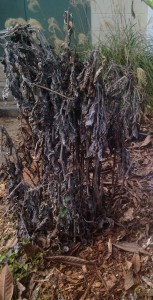When you look out at your landscape nobody has to tell you that winter temperatures in Northwest Florida Afterwards, the temperatures warm up and you feel compelled to do something about it. You just need to “turn your back and slam the door”. “Conceal, don’t feel; don’t let them know”. Cold injury can affect the entire plant or just certain plant or parts such as fruits, flowers, buds, leaves, trunks, stems, or roots. Many plant parts can adapt to tolerate cold. Root systems in the landscape are seldom ‘frozen’ in Florida. “The cold never bothered” them “anyway”. While dead, unsightly leaves may be removed as soon as they turn brown after a freeze, the remaining dry looking stems serve as food storage and should be allowed to remain. If they are removed before the weather is warm enough for the plant to resume growth, the root system may not be enough to support the plant and it will die. So, “let it go, let it go, let it go”. “The perfect” landscape “is gone”. “The past is in the past”. “It’s funny how some distance makes everything seem so small”.Tropical plants and summer annuals do not adapt or harden to withstand temperatures below freezing, and many suffer injury at temperatures below 50°F (10°C). Subtropical plants can harden or acclimate (become accustomed to a new climate) to withstand freezing temperatures, and properly conditioned temperate plants can withstand temperatures substantially below freezing.
Recently planted, unestablished plants may be more susceptible to cold injury. One type of winter injury is plant desiccation or drying out. This is characterized by marginal or leaf tip burn in mild cases and totally brown leaves in severe cases. Desiccation occurs when dry winds and solar radiation result in the loss of more water from the leaves than can be absorbed and/or transported by a cold root system. Plant water needs should be checked after a freeze. Plants may have lost substantial moisture during a windy freeze. Plants will transpire (lose water vapor) on a sunny day after a freeze. Cold injured wood can be identified by lightly scraping the bark with your fingernail and examining the color of the cambium layer (food conducting tissue) just underneath. Green tissue indicates the plant is still alive at that point; black or brown coloration indicates dead or injured tissue. 
After a particularly harsh cold event, some plants may be very slow to recover, so some patience is required. “It will rise” with “the break of spring”. Branch tips may be damaged while older wood is free of injury. Delay pruning until new growth appears next spring to ensure that live wood is not removed. In the meantime, take Elsa’s advice and “let it go, let it go, let it go”. You may be “too relieved to grieve”. I hope I haven’t infringed on any copyrights by letting you know “It’s okay to put off the yard work in the name of plant physiology”.
Enjoy the holiday season!
For more information please see:
- Watch for “Melting Grass” - February 19, 2025
- Palms Can Suffer in the Cold - January 30, 2025
- Camellia Care - January 9, 2025

